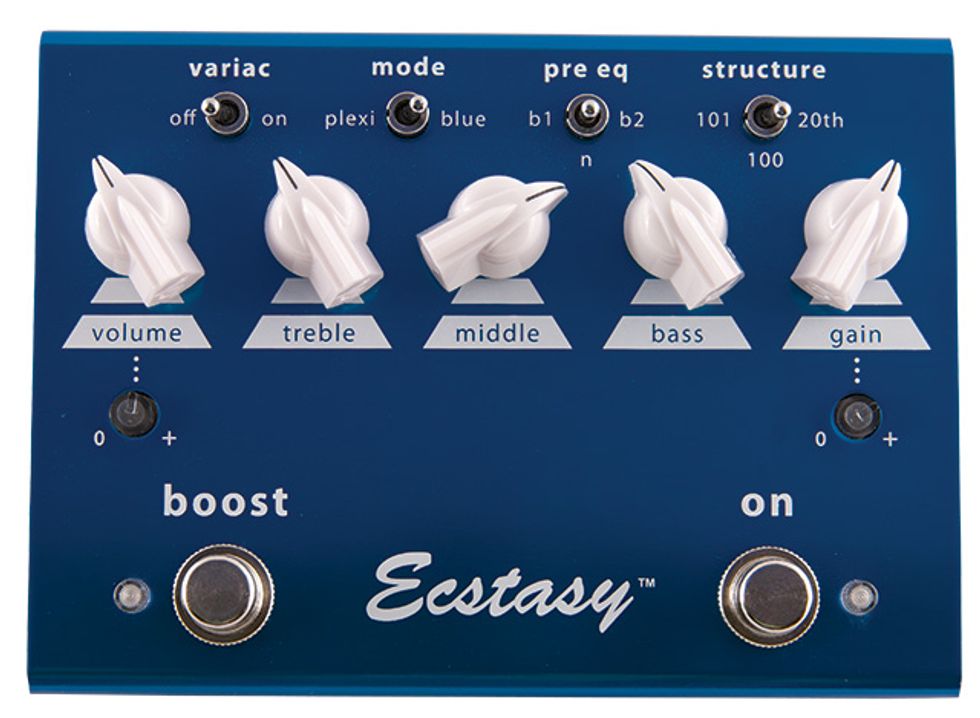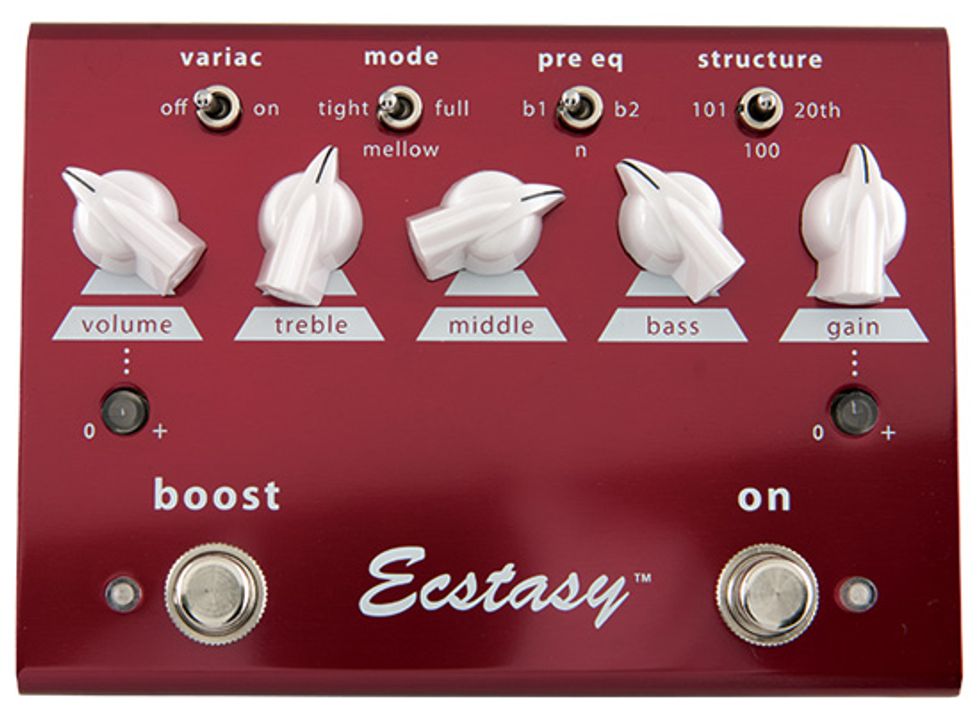When it comes to high-powered boutique amplifiers, few command the respect of the Bogner Ecstasy. The buttery cleans, extreme dynamic range, and guttural overdrive have enthralled fans of hot-rodded British tone since the early ’90s, and for many, Ecstasy amps embody the ideal combination of these qualities. Unfortunately, owning one will set you back thousands of dollars, making an Ecstasy a pipe dream for a lot of guitarists.
Given the exclusivity of his amps, Reinhold Bogner set out to provide a more affordable path for guitarists who want to tap into the Ecstasy’s potent tones. The result is the Ecstasy Blue and Red overdrive pedals—each based on a channel from the Ecstasy series. And with remarkable accuracy each pedal captures the tonal nuances that made the Ecstasy 100, 101, and 20th Anniversary model amplifiers so desirable.
Red vs. Blue
In order to successfully emulate the tones and feel of an actual Ecstasy amp, the Ecstasy pedals both use class A circuits that eschew diodes or op-amps for overdrive clipping. Not surprisingly, each board is populated with select components—Japanese Nichicon and German WIMI caps, gold-plated relays, and Carling switches for true bypassing and boosting. The pedal can also be set for variable voltage, which helps widen their dynamic range and touch sensitivity.
Both pedals share the same simple control layout. There are knobs for volume, gain, treble, mids, and bass, which handle the majority of tone-shaping tasks. Located directly above those are four switches that change the gain structure, response, and feel. The first of these is dubbed variac, which acts like an actual Variac transformer by lowering the pedal’s voltage, giving the tone more sag and pulling back the volume to more neighbor-friendly levels. Next to it is a mode switch that flips between lower (plexi) and higher (blues) gain modes on the Ecstasy Blue, and three different EQ curve and gain presets on the Ecstasy Red.
Each pedal’s pre-EQ switch has two levels of presence and high-end boost, and these can be bypassed completely when set to neutral. But the coolest feature of either pedal might be the 3-way switch that realigns the pedal’s EQ and gain structure to match the three major versions of the Ecstasy amplifier—the 100, 101, and the coveted 20th Anniversary.
Both pedals also have a footswitchable boost feature that can not only boost the volume, but also the gain level at the same time. You can independently set the amount of volume and gain boost via two small potentiometers located directly beneath the pedal’s main volume and gain knobs. The mini-boost pots also house LEDs that light up when you stomp the boost footswitch.
Ecstasy Blue
The Ecstasy Blue excels at producing clear, harmonically rich clean tones, purring low-gain rhythms and biting classic-rock overdrive. And its three-dimensional tone and woody attack are astonishingly close to those of the full-size Ecstasy blue channel.
The Ecstasy Blue’s Plexi mode set to its 100 structure transformed a Fender Deluxe Reverb by embellishing the Deluxe’s rich, clean tone with detailed highs and buttery-smooth lows. Raising the gain control to around 11 o’clock and switching the pre-EQ to B1 gave the Deluxe’s trademark sparkling top end and refined attack a little more body, and the midrange took on a much beefier quality than is typical of a Deluxe.
Ratings
Pros:
Sounds authentically like the actual Ecstasy blue channel. Three modes sound and feel like three different amps. Variable boosting is super-useful.
Cons:
Boosts can’t be set to cut gain and volume individually.
Tones:
Ease of Use:
Build/Design:
Value:
Street:
$299
Bogner
bogneramplification.com
I found the mids to be less aggressive in 101 mode, and the overall tone smoother and a bit more compressed—much like the difference between actual 100 and 101 Ecstasy amp revisions. With a Stratocaster, the 101 mode’s springier low end really lends itself well to blues leads that were just over the edge of breakup.
For overdriven AC/DC riffing and Page-inspired leads, the 20th Anniversary mode and a Les Paul delivered the requisite upper-mid aggression, steel-drum tightness, and velvety overdrive in spades. And it cleans up remarkably well without losing any volume or body when I rolled back the Les Paul’s volume controls.
The boost not only affects the gain and volume, but also the presence in cleaner settings. Boosting the volume to the 2 o’clock position from the 11 o’clock setting made the upper mids much more prevalent and full. Pick attack also became much more pronounced, but without any significant loss in warmth. I also found that boosting the gain slightly with the volume control gave the high end a slightly softer edge, which was really handy when I cranked the Deluxe into slight overdrive and slammed the front end with output from the pedal. This gives you even more power to tailor the Blue to your own amplifier.
Though it can take a little tweaking to nail a tone that’s a match for your own amp, in this case the balance between Bogner’s signature brawny voicing and the Deluxe’s own color was remarkable. And while the Deluxe’s American tonality tends to be a great blank slate for any pedal, the Bogner’s ability to emulate a hot-rodded Marshall without turning the Deluxe into a sputtering, muddy mess says a lot about how carefully this pedal is voiced.
The Verdict
The Ecstasy Blue is a fantastic pedal for both clean tone shaping and
low-to-mid overdrive sounds. Bogner and Co. has captured the natural
woody response, note-to-note clarity, and brawny overdrive that made the
Ecstasy’s blue channel a hit with blues and rock guitarists. And its
ability to get you so convincingly in the Ecstasy’s sonic ballpark at a
fraction of the price is nothing short of remarkable.
Ecstasy Red Bogner’s little red devil aims to capture and bottle up the searing overdrive tones that made Bogner a household name amongst guitarists in the first place. And for all intents and purposes, it succeeds. The Red puts many of the nuances that distinguish the full-sized Ecstasy’s thick and chewy overdrive at your fingertips (and toes) and the pedal’s extremely sensitive EQ section can help you drastically reshape its voice. The note-to-note clarity and dynamics are just as remarkable as the Ecstasy Blue’s, though the cost of massive gain can be noisier output.
With a Twin Reverb and the Ecstasy Red set to its 100 mode and a low-gain setting, the pedal generated the woody midrange and juicy low end that defined the original Ecstasy amp. Every note had enormous body that sustained smoothly and teetered at the edge of luscious feedback when I shook the strings. Easing back on the pick attack for some chunky power chords revealed even more detail in the midrange and created a jelly-like bounce in the low end. This reactivity to picking dynamics has long been a defining characteristic of Bogner’s amps, and the Ecstasy Red nails it.
Things got more ferocious when I turned the gain to 1 o’clock and engaged the B1 presence boost, unleashing a roaring overdrive that’s perfect for dropped-tuned riffing. The 101 mode increases the compression and smoothes out the top end slightly, but retains enough power in the high-mids for Alice in Chains-style hard rock. Even at super-high gain settings, when most overdrive and distortion pedals begin to mush out, the drive remained fluid, dynamic, and powerful. And switching on the variac adds a touch of brown sound with looser mids and slower attack that begged for EVH-style rhythm and lead work.
Ratings
Pros:
Infuses clean tones with the signature Ecstasy high-gain sound exceptionally well. Very responsive to pick attack and playing dynamics. Wide-ranging, sensitive EQ. Three modes have noticeable differences, like having three amps in one.
Cons:
Boost has some background hiss at higher gain settings.
Tones:
Ease of Use:
Build/Design:
Value:
Street:
$299
Bogner
bogneramplification.com
The pedal’s 101 and 20th Anniversary modes unleash the most unrelenting and aggressive tones. The midrange is more snarling in the 20th Anniversary mode than in 100 or 101 mode, and a harder pick attack lends a grittier edge to the highs. Increasing the gain in the 101 and 20th Anniversary modes also seemed to make the already sensitive EQ even more reactive.
When I accidentally moved the treble control from 1 o’clock to 11 o’clock, I thought I’d rolled back the tone knob on my Les Paul. The only control out of the three that seemed to have less of an effect in high-gain settings was the bass control, though it still had plenty of range. The pedal’s only major drawback was how much hiss was present when I had the boost gain set above 3 o’clock. I had no issues with feedback, but the white noise was somewhat excessive, and I was often tempted to dig out my noise suppressor to clamp down on the hiss.
While the Ecstasy Red has plenty of overdrive to satisfy the heavier proclivities of most players, it isn’t really designed with the scooped-mid crowd in mind. I was able to get some seriously heavy tones by scooping the mids down to around 9 o’clock, but since the circuit is dedicated to generating that brawny mid voicing, some of the pedal’s body and detail are lost in these scooped-mid environs. Keeping the mids at 11 o’clock or above highlights the pedal’s strengths. At the end of the day, this is a pedal for heavy players who cut their teeth on hot-rodded British style amps, and really understand how important great midrange presence is in crafting the best heavy tones.
The Verdict
If you’re a rocker who has drooled at the thought of owning an Ecstasy
amp but can’t cough up the required cash, you should take a close look
at the Ecstasy Red pedal. Bogner has done an amazing job replicating the
tone, feel, definition, and response of all three of the Ecstasy’s
variants. Granted, you’ll need a good, blank slate of a tube amp to make
the most of these pedals. But considering how inaccessibly priced most
of these amps are for the average player, laying down $300 for the
company’s flagship overdrive tones seems like a fair price to pay for
the next best thing.















![Rig Rundown: Russian Circles’ Mike Sullivan [2025]](https://www.premierguitar.com/media-library/youtube.jpg?id=62303631&width=1245&height=700&quality=70&coordinates=0%2C0%2C0%2C0)





